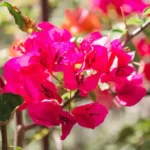In the world of gardens and floral landscapes, there exists a petite yet captivating flower that is cherished for its delicate and vibrant presence. This charming flower, known as the viola, gracefully graces the greenery with its exquisite petals, offering a delightful spectacle of color and form. However, beyond its role as an ornamental gem, the viola beckons us to explore a realm that piques the curiosity of both gardening enthusiasts and culinary connoisseurs alike. The central question that often arises is a culinary conundrum: Are violas edible?
- SUN: A part shade lover, the full sun may be tolerated in cool summer areas.
- SOIL: It is best grown in fertile, moist, well-drained soils.
- TALL: Easily growing up to 6-10 in. tall and 12-18 in. across.
- BLOOM PERIOD: Blooming in late winter and early spring, it provides attractive foliage, fragrance, and color at a season when few other plants are at their peak.
- USES: This plant is very versatile and can be used in beds, borders, underplanting shrubs and roses, cottage gardens, rock gardens, woodland gardens, containers, or ground covers.
Violas
To embark on a journey of discovery into the world of edible violas, it is imperative to first grasp the essence of these delightful flowers.
Botanical Elegance: Violas, scientifically known as Viola spp., are renowned for their botanical elegance. They are characterized by their petite size, ranging from just a few inches to a foot in height, and their distinctive, often multicolored petals. Violas are celebrated for their charming appearance, with some varieties bearing faces or patterns on their petals that seem to wink and smile.
Ornamental Allure: In the world of horticulture, violas have secured a special place as ornamental plants. Their cheerful blooms are often used to adorn flower beds, borders, and containers, bringing a touch of whimsy and color to gardens. Violas are admired for their ability to thrive in various climates, making them a popular choice among gardeners seeking a burst of color from early spring through late fall.
As we embark on the quest to unravel the mystery of whether violas are indeed edible, we first acquaint ourselves with the captivating beauty and botanical diversity of these delightful flowers. With their dainty presence and enchanting appearance, violas invite us to explore the intersection of aesthetics and gastronomy, where culinary creativity knows no bounds.
The Edibility of Violas
The culinary intrigue surrounding violas hinges on a delightful revelation: Violas are indeed edible, offering both visual charm and a mild, slightly sweet flavor.
Petals and Leaves: When considering the edibility of violas, it’s important to note that both the petals and leaves can be consumed. These delicate, flowered delights are not only visually appealing but also offer a subtle floral essence that can enhance a variety of dishes.
Floral Flavor: Viola petals contribute a gentle, floral flavor that is often described as slightly sweet with hints of freshness. This mild taste makes them versatile and suitable for both savory and sweet dishes.
- Viola cornuta are charming little flowers for the old-fashioned garden! This variety, Yellow Perfection, has large lemon-yellow blooms. They are great for containers, hanging baskets, and window boxes, or plant them in mass groupings in the front of the flower border.
- Grows these 6 – 8 inch biennials in USDA zones 6 – 9.
- Butterflies will enjoy the Violas that are in your landscape! They prefer cool conditions, so after they bloom in the spring, cut them back to encourage another bloom again in the fall. They prefer rich, well-drained soil, and they like full sun to partial shade. Once Violas are established, they will often reseed but are not considered to be aggressive.
- After the danger of frost has passed, sow 3 – 4 Viola Yellow Perfection seeds outdoors in a clean, weed free bed. Cover the seed lightly. Maintain moisture until germination occurs. With a temperature 68F, germination is usually within 21 days.
- Space the plants 8 inches apart for optimum growth in full sun to partial shade.
Culinary Uses of Violas
The culinary canvas broadens when violas make their way into the kitchen, adding not only flavor but also visual appeal to a range of dishes.
Decorative Garnish: Viola petals are celebrated for their use as decorative garnishes in culinary creations. Their vibrant colors and intricate shapes transform ordinary salads, soups, and desserts into eye-catching masterpieces. A scattering of viola petals can elevate even the simplest dishes, making them suitable for special occasions and fine dining experiences.
Herbal Infusions: Viola petals find a place in herbal teas and infusions, where they impart a delicate floral note to the brew. Whether enjoyed hot or cold, viola-infused beverages offer a fragrant and soothing experience.
Creative Culinary Exploration: In the realm of gastronomy, creative chefs and home cooks experiment with viola petals in a multitude of dishes. From crystallized petals adorning cakes to colorful additions in fruit salads, the culinary uses of violas are limited only by one’s imagination.
As we continue our culinary journey with violas, we explore the precautions and considerations necessary to ensure their safe and responsible use in cooking. These dainty flowers, with their mild flavor and aesthetic charm, invite us to blend the realms of artistry and gastronomy, enhancing our dining experiences one petal at a time.
Precautions and Considerations
While the inclusion of violas in culinary creations brings forth a world of visual delight and subtle flavors, it is essential to observe certain precautions and considerations to ensure their safe and responsible use.
Source Matters: The source of violas is of paramount importance. It is recommended to source violas from reputable suppliers who cultivate them without the use of pesticides or other chemicals. Violas from well-maintained gardens, particularly those designed for culinary use, are also viable options.
Thorough Cleaning: Before incorporating violas into dishes, it is crucial to thoroughly clean them. Gently rinse the petals and leaves with cold water to remove any dirt or insects that may be present. Pat them dry with a paper towel or allow them to air dry.
Moderation in Consumption: While violas are edible and generally considered safe for most people, it is advisable to exercise moderation in their consumption. Like many foods, excessive intake may lead to digestive discomfort in some individuals.
Allergies and Sensitivities: As with any culinary ingredient, it is important to be mindful of potential allergies or sensitivities. While rare, some individuals may have allergies to certain edible flowers, including violas. If you or your diners have a history of allergies to plants in the Violaceae family (which includes violets and pansies), it is prudent to exercise caution.
Conclusion
In concluding our exploration of the delicate delights of edible violas, we unveil a culinary ingredient that transcends the ordinary. These petite flowers, with their mild, slightly sweet flavor and captivating appearance, have earned their place in the world of gastronomy.
As we venture into the realm where aesthetics meet gastronomy, violas remind us that culinary creativity knows no bounds. From decorative garnishes that transform dishes into visual feasts to subtle floral notes in teas and desserts, violas invite us to explore the artistry of cooking with nature’s delicate gifts.
With responsible sourcing, thorough cleaning, and an awareness of individual sensitivities, violas can grace our culinary endeavors with elegance and charm. As we embrace the world of edible flowers, violas stand as a testament to the harmonious fusion of aesthetics and gastronomy, offering a culinary experience that is as delightful as it is visually enchanting.





